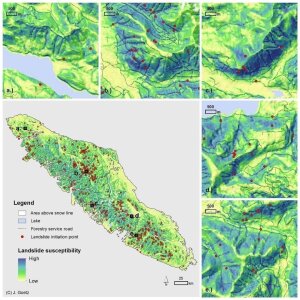Environmental Statistics & GeoComputation
Umweltstatistik & GeoComputation
Image: Jason GoetzStatistical geocomputing at the GIScience Group involves the development and application of novel statistical and machine-learning methods that are required to solve academic as well as practical modeling problems in the spatial domain, as well as their implementation in (mostly open-source) software.
Recent research achievements include the implementation of R software extensions for spatial cross-validation and coupling R with SAGA GIS and QGIS, and the development of the first alpine-wide permafrost distribution model. This research is often driven and inspired by methodological challenges that arise in collaborative research with academic and industry partners in a variety of fields such as remote sensing, ecology or precision agriculture.
-
Researchers
- Prof. Dr. Alexander BrenningExternal link
- Florian Strohmaier
- Pascal Schlechtweg
- Jonathan Frank
- Marco Peña
- Donovan Bangs (University of Waterloo)
- Renfang Liao (University of Waterloo)
-
Current Projects
- Bundesweite Regionalisierung der Nitratbelastung des Grundwassers mithilfe innovativer Methoden der Geostatistik und KI als wissenschaftliche Grundlage für fachliche Vollzugsaufgaben im Grundwasserschutz (REGENI)
- Entwicklung eines geostatistischen Regionalisierungsverfahrens zur Abgrenzung von nitratbelasteten Gebieten in Schleswig-Holstein
-
Completed Projects
- Wissenschaftler Rückkehrprogramm der German Scholars Organization und der Carl Zeiss Stiftung
- NSERC Discovery Grant - Individual (at the University of Waterloo, Canada)
- Humboldt Research Fellowship (sabbatical of A. Brenning at the University of Heidelberg)
- Permafrost Favorability Index Map for the Chilean Semi-Arid AndesExternal link
-
Selected Publications
- Albuquerque, J. P., Herfort, B., Brenning, A. & A. Zipf (2015). Geographic approach for combining social media and authoritative data towards improving information extraction for disaster management. International Journal of Geographic Information Science, 29(4): 667-689.
- Iturritxa, E., Mesanza, N. & Brenning, A. (2015). Spatial analysis of the risk of major forest diseases in Monterey pine plantations. Plant Pathology, 64(4): 880-889.
- Goetz, J. N., A. Brenning, H. Petschko, P. Leopold. Evaluating machine learning and statistical prediction techniques for landslide susceptibility modelling. Computers & Geosciences, submitted, 81: 1-11.
- Brenning, A., M. Schwinn, A. P. Ruiz-Páez & J. Muenchow. 2015. Landslide susceptibility near highways is increased by 1 order of magnitude in the Andes of southern Ecuador, Loja province, Nat. Hazards Earth Syst. Sci., 15, 45-57, doi:10.5194/nhess-15-45-2015.
- Zandler, H., A. Brenning & C. Samimi. 2015. Quantifying dwarf shrub biomass in an arid environment: comparing empirical methods in a high dimensional setting. Remote Sensing of Environment, 158: 140-155. doi:10.1016/j.rse.2014.11.007
- Peña, M.A., A. Brenning & A. Sagredo. 2012. Constructing satellite-derived hyperspectral indices sensitive to canopy structure variables of a Cordilleran Cypress (Austrocedrus chilensis) forest. ISPRS Journal of Photogrammetry & Remote Sensing, 74: 1-10.
- Knudby, A., A. Brenning & E. LeDrew. 2010. New approaches for modeling fish-habitat relationships. Ecological Modelling, 221: 503-511
